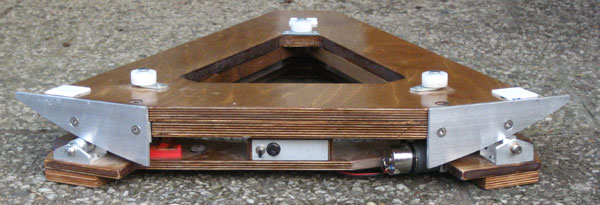vns eq platform

|
vns eq platform |
|
|
The equatorial platform of my 22" lowrider Dobson is basically very similar to the platform of my 14" Dobson, which has its own web page where the working principles of such a platform are explained in detail. However, to account for the higher weight of the 22" Dobson of 45 kg as compared to the 26 kg of my 14" Dobson, the platform for the big Dobson needed to be considerably more stable. Nevertheless, it should remain as low as possible to maintain the low eyepiece position of the Lowrider. The overall height of the platform is 85 mm and the platform replaces the 25 mm high ground board of the telescope. The net height of the platform is therefore a mere 60 mm ... the right lowrider platform for a lowrider Dobson!
As compared with the small 14"er platform I changed a few things with the big platform to further increase its sturdiness. I replaced the southern axial bearing by a simpler bearing and replaced the inclined circle segment of the northern bearing by vertical segments (VNS, vertical north segments). The latter simplified the roller bearings and increased stability, but also increased the complexity of making the segments. For smaller Dobsons, a conventional inclined circle segment might be the easier solution. |
|
|
The ground board of the platform is made of 12 mm plywood and was slightly reinforced at the sides. |
|
|
The platform table consists of 18 mm plywood and was reinforced along both its long and short axis by 20 mm plywood beams, to considerably increasing the rigidity of the platform. |
|
Northern Bearing
|
The usual circular segment for the northern bearing is only a special case of a continuum of possible shapes, which all are sections of a cone. This cone is defined by the polar axis and an angle, which is slightly larger than the geographical latitude (otherwise the segment would not be below the horizontal table). For a circular segment, the plane of the section is perpendicular to the polar axis. In our alternative approach, we can put the plane of the section perpendicular to the platform table. What we get is an ellipse or a hyperbola (see conic sections on Wikipedia). The advantage of vertical northern segments (VNS) is the more direct transmission of the weight of the Dobson to the ground plate and the simpler design of the roller bearings and the motor drive. |
|
|
The VNS segments can be made by a jig that simulates the complicated movement of the segments' bearing surface on the rollers. This is nicely shown on the web page of Ulli Vedder. Alternatively, the shape of the VNS segments can be calculated and drawn to scale. This can be done analytically, but this is complicated. It is much more simple to start from the inclined circular segment. The shape of the vertical elliptical segment is obtained by compressing this circle by a factor of cos alpha (where alpha is the geographical latitude). The circle segment turns to an elliptical segment. This procedure is best done using some simple graphic software, from which you can print out the part of the segment that you need (even Powerpoint could do this). |
|
|
Furthermore, the elliptical segment was split into two segments, that were slightly turned by an angle beta around a vertical axis to align it with the movement of the platform table. This decreases the amount of lateral movement of the segment on the rollers during operation of the platform. To account for this, the segments need to be stretched by a factor 1/ cos beta. |
|
|
As the segments do not remain perfectly vertical during the movement of the platform table, it is of advantage to keep the segments comparatively thin. To retain stability, the segments were made of 5 mm alloy, cut according to the to-scale-drawing, trimmed, and mounted to the platform table by L-shaped profiles. The bearing surfaces were rounded to allow for the tilting movement of the segments during operation. It is important that there is enough friction between drive shaft and segment. Steel or hard aluminum alloy segments might have to little frictions, soft aluminum alloys might not be resistant enough. I found that AlMgSi0.5 alloy (often used for extrusion profiles) works well.
The left roller consists of a piece of tube with matching ball bearings, while the right bearing serves as drive unit (see below). |
|
|
I have modified the platform of my 14-Inch Dobson and have added vertical segments also to that platform. The segments are made of 3mm aluminum profiles that are mounted under the platform table. |
|
|
The southern bearing is as simple as possible, consisting of a rounded bolt running in a conical depression. Together with the northern bearings, this is sufficient to define the polar axis. |
|
|
The platform is powered by an RB35 1:600 geared DC motor (Conrad electronics) and a 1:20 worm drive and a steel drive shaft driving the platform by friction. Due to weight of the Dobson and the vertical force transmission, the friction is high enough to prevent slipping. The relatively thin drive shaft (5mm) causes in the long term some wear on the segment surface. It is therefore better to use a somewhat thicker shaft. More about the drive unit and the electronics is on a separate page here. |
|
Here are ready-to-use construction plans for the two VNS platforms shown on this page. |
|
![]()
home introduction cs platform vns platform drive system planning construction plan